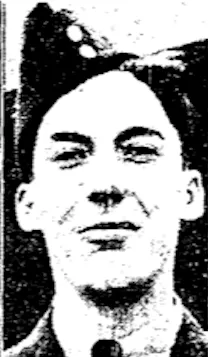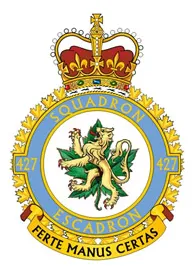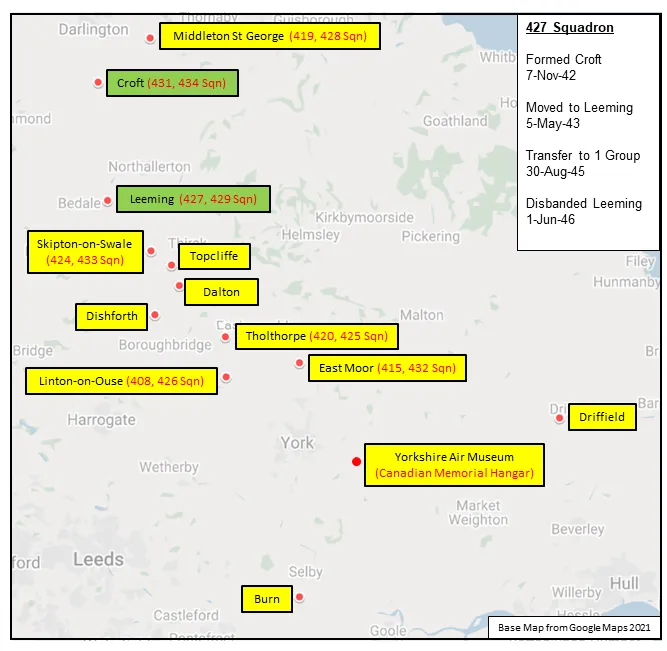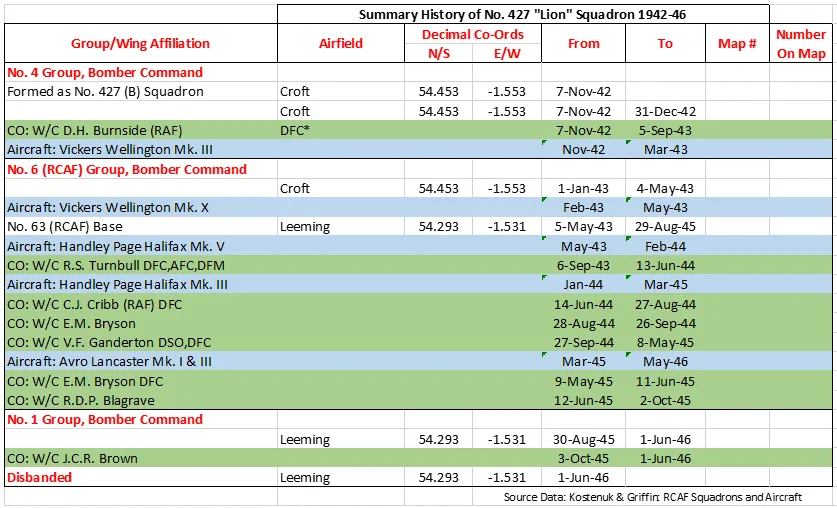Heather, Roderick John
Killed in Action 1943-03-12


Birth Date: 1922
Born:
Son of A. O. Heather and Eileen Heather, of Toronto, Ontario.
Home: Toronto, Ontario
Enlistment:
Enlistment Date: Unknown
Service
RCAF
Unit
427 (B) Sqn- Squadron
Ferte Manus Certas Strike sure
Base
Rank
Pilot Officer
Position
Pilot Officer
Service Numbers
J/16756
Home
 Toronto, Ontario
Toronto, Ontario
First Burial
 Haverhill Cemetery, Suffolk, Uk
Haverhill Cemetery, Suffolk, Uk
Vickers Wellington

Vickers Wellington B. Mk. III (Serial No. X3763), coded KW-E, No. 425 'Alouette' (B) Squadron, RCAF, late summer of 1942
The Vickers Wellington was a British twin-engined, long-range medium bomber. It was designed during the mid-1930s at Brooklands in Weybridge, Surrey. Led by Vickers-Armstrongs' chief designer Rex Pierson, a key feature of the aircraft is its geodetic airframe fuselage structure, which was principally designed by Barnes Wallis. Development had been started in response to Air Ministry Specification B.9/32, issued in the middle of 1932, for a bomber for the Royal Air Force. This specification called for a twin-engined day bomber capable of delivering higher performance than any previous design.
The Wellington was used as a night bomber in the early years of the Second World War, performing as one of the principal bombers used by Bomber Command. During 1943, it started to be superseded as a bomber by the larger four-engined "heavies" such as the Avro Lancaster. The Wellington continued to serve throughout the war in other duties, particularly as an anti-submarine aircraft.
It holds the distinction of having been the only British bomber that was produced for the duration of the war, and of having been produced in a greater quantity than any other British-built bomber. The Wellington remained as first-line equipment when the war ended, although it had been increasingly relegated to secondary roles. The Wellington was one of two bombers named after Arthur Wellesley, 1st Duke of Wellington, the other being the Vickers Wellesley.
In August 1936, an initial order for 180 Wellington Mk I aircraft, powered by a pair of 1,050 hp (780 kW) Bristol Pegasus radial engines, was received by Vickers; it had been placed so rapidly that the order occurred prior to the first meeting intended to decide the details of the production aircraft. In October 1937, another order for a further 100 Wellington Mk Is, produced by the Gloster Aircraft Company, was issued; it was followed by an order for 100 Wellington Mk II aircraft with Rolls-Royce Merlin X V12 engines. Yet another order was placed for 64 Wellingtons produced by Armstrong Whitworth Aircraft. With this flurry of order and production having been assured by the end of 1937, Vickers set about simplifying the manufacturing process of the aircraft and announced a target of building one Wellington per day.
A total of 180 Wellington Mk I aircraft were built; 150 for the RAF and 30 for the Royal New Zealand Air Force (RNZAF) (which were transferred to the RAF on the outbreak of war and used by 75 Squadron). In October 1938, the Mk I entered service with 9 Squadron. The Wellington was initially outnumbered by the Handley Page Hampden (also ordered by the Ministry to B.9/32) and the Armstrong Whitworth Whitley (to B.34/3 for a 'night' bomber) but outlasted both rival aircraft in service. The Wellington went on to be built in 16 separate variants, in addition to two training conversions after the war. The number of Wellingtons built totalled 11,462 of all versions, a greater quantity produced than any other British bomber. On 13 October 1945, the last Wellington to be produced rolled out.Wikipedia
 YouTube Vickers Wellington documentary
YouTube Vickers Wellington documentary
427 (B) Sqn Ferte Manus Certas ("Lion")
History of the Squadron during World War II (Aircraft: Wellington III, X, Halifax III, V, Lancaster I, III)

427 Squadron was the RCAF's 25th squadron and eighth bomber squadron to be formed overseas in WWII. It was formed at Croft, Yorkshire, England on 7 November 1942 as part of No 4 Group of RAF Bomber Command. With squadron code letters ZL it flew Wellington Mk III aircraft. On 1 January 1943 it joined No 6 (RCAF) Group, remaining at Croft until May of 1943, when it moved to Leeming, Yorkshire , where it remained for the rest of the war in Europe. Its duties were to take part in strategic and tactical bomber operations. It briefly re-equipped with Vickers Wellington Mk X before acquiring Handley Page Halifax Mk V aircraft in May 1943. In January 1944 it re-equipped again with the improved Halifax Mk III. Finally it was equipped with Avro Lancaster Mks I and III in March 1945. After the termination of hostilities in Europe, the squadron remained in England and transferred to No 1 Group. It participated in operation EXODUS, the repatriation of POW's and operation DODGE, bringing back British troops from Italy. The squadron disbanded at Leeming on 1 June 1946.
In the course of WWII the squadron flew approximately 3300 operational sorties in the course of which either 88 (Moyes) or 90 (Kostenuk) aircraft were lost and approximately 10,300 tons of bombs were dropped. The squadron earned 4 DSO's, 147 DFC'c and 6 Bars to DFC, 1 AFC, 2 CGM's, 16 DFM's and 8 MiD. Battle Honours were: English Channel and North Sea 1943-45, Baltic 1944-45, Fortress Europe 1943-44, France and Germany 1944-45, Biscay Ports 1943-44, Ruhr 1943-45, Berlin 1943-44, German Ports 1943-45, Normandy 1944, Rhine, Biscay 1944. Wikipedia, Moyes, Kostenuk and Griffin
Squadron History (Bomber Command Museum PDF)
Maps for Movements of 427 Squadron 1942-46

427 Squadron History Summary 1942-46

History of the Squadron Post-WWII (Aircraft: Sabre 2, 5, 6, Starfighter, Kiowa, Twin Huey, Griffon)
The squadron was reactivated on 1 August 1952 as a fighter squadron in the Air Defence Command, based in St Hubert, Quebec and equipped with Canadair F-86 Sabre Mk 2s. The Squadron moved on to Sabre Mks. 5 and 6 while working out of St Hubert before deploying to Zweibrücken, Germany and becoming a part of 3 Wing, in March-April 1953. The Squadron continued in this role, operating out of Germany, for another decade, participating in many multi-national NATO exchanges and exercises with destinations including; Rabat, Morocco, Decimomannu, Sardinia and France. The squadron moved to Grostenquin, France in June 1962, but was inactive pending its conversion to the CF-104 Starfighter. On 15 December 1962, the Squadron was deactivated as a Fighter squadron and reactivated on the 17th as a Strike/Attack squadron, becoming the first Canadian squadron to be equipped with the Starfighter. This change in aircraft necessitated changes in training and tactics. In 1969 the squadron moved from Zweibrücken to Baden-Soellingen , and with that, a change from 3 Wing to 4 Wing.
The Squadron disbanded again on 1 July 1970 and was re-established on 1 January 1971 as a Tactical Helicopter Squadron with 10 Tactical Air Group of Mobile Command, later simply called ‘Air Command.’ The first helicopter used after this transition was the CH-136 Kiowa light observer helicopter and, simultaneously, the CH-135 Twin Huey utility helicopters. The Squadron participated in many operations, including: Norway, Egypt, Sinai and Central America. After switching to a fleet of only CH-135 Twin Hueys in 1992, the squadron deployed to Somalia in 1993 and to Haiti on Operations. In July 1997 the Squadron received the BELL CH-146 Griffon Helicopter fleet to replace the Twin Huey. By 1999, the Griffon’s had participated in operations in Canada and in Honduras. The early 2000’s saw rotations going to Bosnia.
On 1 February 2006, 427 Squadron became part of Canadian Special Operations Forces Command (CANSOFCOM), as a Special Operations Aviation Squadron (SOAS), with the responsibility of providing air capability to various units with the Canadian Special Forces Command, where it remains today, located at Canadian Forces Base Petawawa, Ontario . In recent years, 427 SOAS participated in Exercise FLINTLOCK, an annual regional exercise among African, Western and United States counterterrorism forces, in multiple countries in West Africa. It also deployed to the Middle-East as part of Operation IMPACT, the Canadian Armed Forces mission to build the military capabilities of Iraq, Jordan and Lebanon, and set the conditions for their long-term success. 
 Canadian Virtual War Memorial
Canadian Virtual War Memorial Wikipedia Vickers Wellington
Wikipedia Vickers Wellington RCAF - Vickers Wellington
RCAF - Vickers Wellington